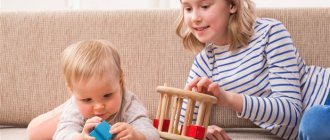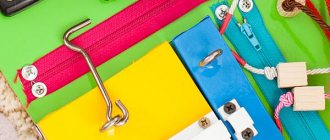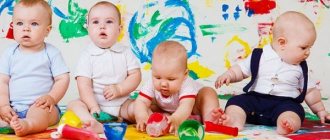Look at your child today - he has become a real researcher, he is interested in everything. In any free moment, a one-year-old baby explores the world. If earlier you and the baby were one whole, now a child at 1 year begins to recognize himself as an independent person.
Psychological characteristics of children of the second year of life
After a year, the baby is no longer that peacefully sleeping (or constantly crying) bundle in the crib. During the first twelve months of life, a child has mastered a huge number of skills, but even more discoveries await him. Various educational activities for 1-year-old children will be excellent helpers in this regard.
At this age, children, along with independence and an irrepressible desire to constantly study their surroundings, exhibit fears and doubts. It is very important that parents help their child cope with the first difficulties; this will help him not be afraid to make new discoveries, which means that the answer to the question of how to develop a child at 1 year old will come on its own. Kids are very wise; they naturally have a real thirst for knowledge. They try to imitate their parents in everything, and this feature is an excellent opportunity to encourage the child to learn new things by example.
Examples and descriptions of developmental activities
Working with a child at the age of 1 is important in the direction of his intellectual development.
To do this, the baby should be taught little by little:
- account;
- alphabet;
- flowers;
- names of animals.
This information will be very easily deposited in the child’s head and will help him in the future when he learns to read and write, as well as learn about the world around him.
Introduction to letters
You can teach a one-year-old child letters using:
- books in which the letters are depicted large with some kind of illustration. During the lesson, an adult must clearly pronounce the names of the letters and voice what exactly is depicted;
- cards with pictures - mom or dad show the baby cards and pronounce each letter, and then ask the child to find the letter they call among all the pictures;
- sound alphabet - this alphabet is often found in various toys and books. While listening to it, the baby remembers the letters and their order in the alphabet;
- cubes with letters - at the same time, the child not only learns to build a pyramid or tower, but also learns the alphabet;
- magnets - a visual demonstration of letters helps the baby remember the letters faster. Such magnets with the alphabet can be placed on a special board or even on the refrigerator and the baby will show interest in them.
Cubes with letters, magnetic alphabet and alphabet in pictures will help in teaching a one-year-old baby letters.
You can also draw letters on paper with bright markers for your child, while pronouncing their names. All lessons for learning letters should be structured in such a way that the child remembers them and, at the request of the parent, is able to find the necessary symbol.
Training should not be long and tiring for the baby. To get the basics, it will be enough to do any of the above methods (or several of them) 2-3 times a week for 7-9 minutes.
Studying numbers
Many parents begin to introduce their children to basic basic counting even before the age of 1, by singing and telling them counting songs and counting nurseries. A child at this age is still too young to understand and remember the order of numbers and their quantitative designation, but such activities will not hurt for general development.
After 1 year, you can teach your child counting and numbers purposefully and then, closer to 2 years, he will be able to independently count to 10 or even 20.
To study numbers, you can use puzzles with numbers and the corresponding number of objects
The classes are structured as follows:
- teach the child to memorize numbers by ear, simply by pronouncing them;
- calling numbers, show the corresponding number of objects (balls, cubes, balls);
- show cards with numbers and images equal in number to this number;
- teach the child the concept of “a lot and a little” by placing them in two piles, for example, a lot of cubes and 2-3 cubes separately.
As a result of such activities, the baby will eventually learn to show on cards the numbers that are asked of him, and later to name them.
Colors
Research shows that children begin to perceive colors and shades by 2-3 months of age. They first learn to distinguish between red, orange, yellow and green. At the same time, many children tend to identify their favorite toy by color, which is noticed by parents and other relatives. However, the ability to consciously find an object of one color or another appears only at 1-1.5 years.
The study of colors, as well as letters and numbers, should be carried out in a playful way, for example, putting together animal figures by color
Starting from 1 year old, you can start learning colors with your child in a playful way, following these recommendations:
- To begin with, the baby is introduced to 4 primary colors - blue, yellow, red and green, and then all other shades are gradually added. You should not introduce the child to the next color if he has not yet sufficiently remembered the previous one;
- training should be built in a playful way and not be lengthy;
- You should not deliberately name colors in a distorted form; let the child remember the full names, and not diminutive names (for example, yellow, not yellow, green, not green);
- when introducing each new color, the child should name as many objects of this tone as possible (for example, a green leaf, a green ball, a green cube) so that he does not have associations as if one object can only be of one shade;
- to visually demonstrate colors, you can use cards from which, after familiarizing yourself with the colors, the child is asked to choose one or another tone;
- A very effective technique is based on painting with paints (gouache, watercolor). With the help of an adult, a child can draw the simplest elements while simultaneously studying colors;
- Another good way to teach colors is to sort different objects and toys by color. The child can be asked to collect only red balls or cubes from the total mass, or to match together toys that are the same color but different in shape (parts of a pyramid, construction set).
When teaching colors, it is important to be patient and understand that the baby may be confused about the shades for a long time, however, this does not mean that he does not remember anything. As soon as he grows up a little, he will easily not only show objects of different colors upon request, but also name them.
Animals
As a rule, children of this age and older study animals with particular joy, as they like to repeat the sounds they make and look at them in pictures.
Many parents, even before the child turns 1 year old, begin to tell and show him various animals, depicting them, entertaining the child with nursery rhymes (horned goat, cat), and also showing the child cards using various methods (Montessori, Doman cards).
After the baby turns 1 year old, you should systematize such activities and choose the most appropriate tactics.
Live communication between children and animals also contributes to their learning
You can do this as follows:
- using sets of plastic and wooden toys. A child can not only find out the name of an animal, but also touch it and play with such a toy;
- using special recesses you can make animal figures from plasticine or modeling dough;
- Watching thematic videos for a short time will also allow the baby to better navigate the animal world;
- reading books to a baby should be accompanied by showing images of animals, if pictures with them are found in the text;
- use a variety of cards that depict animals and birds. First, you should tell your child about each animal, and then ask him to find their images;
- allow the child to contemplate the animal world in its natural form - in the village, at the dacha, in nature reserves and parks, while explaining to him exactly who he sees and how this or that animal can “speak” (for example, a crow croaks, a cow moos, a cat mew).
Physiology of children 1-2 years old
Provided proper development, by the age of one year the baby begins to walk independently. Much to the amazement of his parents, a month after taking his first steps he can walk quite confidently without assistance, and after another two months he begins to run. The growth rate during this period slows down somewhat; the body spends enormous resources on developing all the baby’s systems. Including his dexterity and coordination of movements. Sports educational games for children 1-2 years old can help with this:
- ball games;
- classes at a sports complex or wall bars;
- exercises and simple gymnastic exercises;
- swimming in a large bathtub or pool.
At this age, it is very important not to limit the child’s physical activity. Walking in the fresh air - in the park and on special playgrounds - is an excellent opportunity to give your child plenty of time to run around and show his spirit of exploration. How to develop a child at 1 year old, if not through communication with the outside world?
How to develop gross motor skills in a 1 year old child
- Jumping. Take the baby under the armpits or by the arms, he should jump on the spot.
- Climbing onto the sofa and sliding back down. The stimulus in this case may be a favorite toy.
- Climbing. Have your child crawl under a chair, climb into and out of a large box.
- Stepping over. It is necessary to lay out various objects on the floor and, taking the baby by the hand, walk with him around the room. When approaching an obstacle, teach your child to step over the object with both feet: first with one foot, and then with the other.
- Ball games. Teach your child to throw the ball on the floor, give the ball in his hands, and then just put him near the baby and let him take the ball on his own. Afterwards, show how you catch the ball.
Early child development
There are a huge number of myths and legends surrounding this topic. Opponents and supporters of early development have diametrically opposed points of view. Some believe that the child should learn everything himself when the right time comes. Others sincerely believe that it is possible and necessary to teach a child almost from birth (in support of this theory, teachers create special didactic materials for their little charges, educational games for children from 1 year old).
Scientists are clear in their opinion: a child is a blank sheet of paper. Until the age of 4-5 years, his brain is able to remember and assimilate huge amounts of information, so why not take advantage of this, and along with the knowledge necessary for self-care, help the child quickly master speech, teach him to distinguish colors, shapes and animals?
Montessori school
One of the most popular areas in early pedagogy is the Montessori system, which teaches parents how to develop a child at 1 year old. Created by the Italian Maria Montessori in the first half of the 20th century, this system found supporters in many countries. What is it? Initially, Maria Montessori worked with children who had various developmental delays. Over time, her methods began to be used to raise absolutely healthy children.
In this technique, teachers and psychologists teach the child to make decisions, to be independent in his judgments and actions, but at the same time obey generally accepted rules and norms. It is noteworthy that there are no toys as such in the groups where children study according to this system. It is impossible to find a car, a gun or a doll there; on the contrary, children are engaged and studying. Educational toys for children 1-2 years old help them with this:
- cubes;
- pyramids;
- sorters;
- puzzles;
- musical instruments.
Classes according to the Montessori system involve the development of self-service skills in a child, that is, the baby must learn to play, eat, and drink independently. If parents and at home systematically adhere to these principles, then the child grows up to be a self-sufficient person, who has been instilled with the norms of communication in society since childhood. Such a child is able to cope with conflict situations and come out of them with dignity.
In Moscow, special developmental centers have also been created for children from 1 year old, based on Montessori pedagogy: “Steps”, “Montessori Garden”, “Early Development Club” on the street. Trofimova and many others.
If you want to develop your child, develop yourself
When my friends are surprised by my child’s curiosity, activity and friendliness and wonder how to achieve this, I try to unobtrusively find out: what kind of life does the mother herself lead? What do you do in your free time? Does he travel anywhere with his child? Does he read books to him? Does she read it herself?
Most often, it turns out that the mother is surrounded by household chores, somehow manages to prepare dinner for the whole family, cleans up during the baby’s nap, or watches a TV series. Many even complain that they do not have time to walk with their child more than 1-1.5 hours a day, so much work accumulates! In general, it is generally accepted that spinning around at home like a squirrel in a wheel is normal . What kind of developers are there?
But the fact is that children copy, first of all, their mother. And they will look at the world through her eyes for a long time. Not in the literal sense, of course. But the mother’s attitude will certainly be passed on to the child.
That is, if mom is hooked on soap operas on TV, the baby will think that watching the box all day long is good. If the mother does not read books, the child is unlikely to develop this interest. And poor nutrition is completely absorbed into mother’s milk...
If the mother herself leads an active lifestyle - she goes to parks, museums, goes to the pool or yoga, meets with friends and their kids (and, of course, takes her own child with her!), then the child will be inquisitive and active . If the mother is doing what she loves - for example, blogging or working remotely, then the baby will learn to find activities for himself, seeing that the mother is busy and being “in business” is normal. If a mother goes hand in hand with sports, the children will certainly awaken an interest in physical exercise. From the first months they will be able to help in physical education classes! You will see this by reading my article Fitness with a baby in your arms: 5 effective exercises for a mother with a baby.
In short, in order to develop a child correctly, you must first take charge of yourself . Develop positive thinking, broad-mindedness, ease-of-mind and curiosity. Maternity leave is generally a wonderful and, perhaps, the only opportunity to learn everything that you didn’t have time for before, to go where you didn’t have time, and to discover qualities in yourself that you didn’t even suspect about before. To be inspired for achievements, I highly recommend studying the article Busy life on maternity leave - it’s real!
I know mothers who do not leave the yard until the child is three years old, and it happens that they sit at home for a whole week. Does a child develop in such conditions? Of course, where will he go? But many times less than children whose mothers are not afraid to step out of their comfort zone. And the most important thing is that they develop themselves.
Is it necessary to torture a baby?
Early child development is not an easy process for both the baby and his parents. Having chosen one tactic of behavior and created certain rules and norms, you should not succumb to temptation and deviate from the given course.
When parents decide for themselves an important question regarding the future of their child: “We are developing a child at home, 1 year is the right age,” it is very important that mom and dad work together with him. In no case should you go too far, otherwise you can achieve the opposite effect - the child will withdraw into himself. At this age, a little person learns many things through the prism of comparison, imitation, and only in a playful way. Therefore, even educational games for children 1-2 years old should be interesting for the baby.
During independent studies, you should not press on the child; If he’s not interested, he’s not feeling well, or he’s busy with something else that’s important to him, you need to let him play to his heart’s content. Learning will bear fruit only when it occurs in an atmosphere of mutual disposition of both the student (child) and his teacher (mother). Then the process will bring pleasure and, of course, a result that will not take long to arrive! Many parents are confused by the question of whether children at this age can watch cartoons? As practice shows, it is almost impossible to completely protect a child from the benefits of modern civilization, but if you approach the issue wisely, give your child the opportunity to watch educational cartoons for children 1-3 years old, but not for long and only those that are age-appropriate, nothing bad will happen .
Books
When conducting educational activities for children 1-2 years old, without a doubt you need to read books to them and show them pictures. At this age, children absorb all the information provided like a sponge. Even though their speech is not yet developed, everything new is accumulated in the brain. Soon the knowledge gained will spill out. You need to tell the children, show them, explain absolutely everything. It is very interesting for kids to look at in books what they have already encountered in their lives. Therefore, they begin to love them at an early age.
Basically, books for one-year-old children are somewhat similar. They are not replete with text; the main thing in them is colorful, beautiful pictures. There is an acquaintance with the outside world: family, toys, animals, seasons, colors, plants. How to choose a specific book? Listen to your own opinion. In terms of content, based on your artistic taste, you can choose anything. As for technical points:
- Illustrations must be of high quality. As little text as possible.
- Preference for short poems and fairy tales. The child will not be able to listen for a long time if the text is very large, he will quickly lose interest.
- The book must be completely safe. Do not buy dubious publications that have a strong smell or washable colors. This can harm the baby's health.
It is difficult to single out the “best” educational books for a 1-year-old child. The modern market is overfilled with these products. You can give preference to our old, well-proven fairy tales, which were favorites in every family. But it’s not a fact that your baby should like the same thing. Modern children differ in many ways from older generations in their development, so watch your child and note for yourself what he prefers.
What shall we play?
After a year, children begin to take the first steps towards their socialization. They learn to play together with their mother, brother or sister. The older the baby gets, the wider his social circle becomes. He makes new friends on the playground, he looks at them with pleasure, listens and tries not only to watch other children play, but also to participate in the process.
During this period, educational games for children from 1 year old can be varied. It is very important to give your child the opportunity to develop motor skills; for this you can create a few simple activities (under parental supervision!):
- Sorting various small items - for this you can take large beads, natural materials (chestnuts, nuts), pompoms. They can be of different colors or textures; the child must arrange the items in separate trays or cells.
- Transfusion, oversleeping is a very important aspect in the development of a child. Playing with water, kinetic sand, and cereals is exciting and useful, developing perseverance and spatial thinking.
- Drawing – you shouldn’t expect your child to create a masterpiece, but the process itself will bring him and his parents pleasure. You can draw with anything - chalk, pencils, paints (finger paints, gouache, watercolors).
Such developmental activities for 1-year-old children will help show the child the difference between big and small, he will learn to recognize his tactile sensations, this also contributes to speech development.
Don't forget about outdoor games. You can learn to do simple physical exercises with your child: show him how to squat, walk in place, play with balls of different sizes.
Tools at hand for learning
The child studies the world around him, so all means are good for this. As I already wrote, involve your household in the process. Tell your little one who is who, what color grandma’s dress is, what she’s doing in the kitchen. If the little one pays attention to the light bulb, tell him that the light is shining, show him how it turns on. Such simple things, at first glance, will cause delight.
Our games with Dominic in the kitchen develop fine motor skills, as well as games for sensory development.
And for games use:
- Krupa
- Clothespins
- Dishes (wooden, plastic)
- Old bag
Groats
You can do different manipulations with cereal. For example, pour semolina into a basin, hiding a rattle there. You can put beans, buckwheat, and lentils in front of the fidget. Roll out the plasticine on a sheet of paper and let the grains stick into it. Another interesting tip: put socks on your baby, add buckwheat to the second pair and put them on his feet. Let it go like this for half an hour. Great foot massage!
Clothespins
Small, loose ones will do. They are put on a piece of cardboard, ask your baby to take them off.
Dishes
This attribute is good in deep size. You can pour something in, rearrange it, etc. When you bathe a tomboy, you can use the dishes to pour water or pour it on yourself.
Old bag
This is a gift from fate for the little explorer! Just get all your things out of there. And put the same rattle or a small bunny. Let him search. You can put a lot of funny things in there.
In addition, you can read poems and sing songs. Ask the child to repeat after you. He will play his sounds, albeit short ones, but these are his attempts!
What to play?
Often, parents, in search of the perfect toy, get lost and buy everything. Giving such freedom of choice to a child is inappropriate. Due to his age, he is not yet able to do it and stop at one thing, especially on his own. Educational toys for children over 1 year old should be at home, but their compliance with the age and level of development, as well as the preferences of the child himself, is a prerequisite. What can you offer:
- cubes, “Town” constructor;
- various pyramids;
- wooden puzzles, insert frames;
- sorters of various modifications - with geometric shapes, animals, fruits and vegetables;
- construction set with large elements;
- large mosaic (plastic, magnetic or wooden);
- dolls, baby dolls;
- reliable machines, including pushers.
Sometimes educational cartoons for children from 1 year old provide a useful idea of what to play with for parents and their baby. Their characters, as well as an unobtrusive form of teaching, help the child understand what to do with the toys.
Games with cubes, pyramids and sorters
Modern children usually have enough toys, but it is very important that among them there are various kinds of sorters (houses, cars, plastic balls with holes), pyramids and cubes. By the age of 1, many children can already assemble a simple pyramid and build a small tower. Next, you should develop this skill by making tasks more difficult for it.
For classes, it is better to choose pyramids that have a thin core for collecting rather than a cone-shaped one, since the latter option is simpler and children quickly master it. This toy helps your baby understand size differences and learn to count rings.
As for the cubes, they can be anything - plastic, soft or wooden. While playing with them, a child can, in addition to building a tower, put them in a row, build garages and paths. This game promotes the development of three-dimensional imagination and helps the child learn the basics of symmetry and geometry.
Games with sorters develop logic, train attention and help learn shapes
Many teachers and parents consider sorters to be the best educational toys because they:
- develop logic;
- form the skill of comparing objects;
- introduce the outlines of figures;
- train memory and attention.
As a rule, sorters are made of plastic or wood. The figures can be of various shapes - circles, ovals, squares, animal silhouettes. The baby’s task is to place each of them in the right hole.
Learning to talk
At one year of age, many babies have a sufficient vocabulary, which makes it possible to maintain communication with their mother. He knows who is who in his environment, he can ask for food, drink, express approval or displeasure. The whole next year is significant - the child’s vocabulary will grow by leaps and bounds, this largely depends on the parents themselves. You need to talk to the child, comment on all the processes, but do it in accessible and simple language.
Educational cartoons for children aged 1 year and older with short songs and rhymes are great helpers in this regard. Their simple rhymes and simple words are easy to hear, and the combination of sound and image allows the child to quickly learn the names of the characters and their actions.
Developing fine motor skills
The nerve endings that control finger coordination are located in the brain, in close proximity to the center responsible for speech. Therefore, any finger games will help the baby start talking faster.
How to develop motor skills of a 1 year old child? Give your baby a light massage of his palms and fingers, while mixing up the mechanical stroking with various nursery rhymes and songs. See how he likes it.
You can give tasks. Play with beads. Try to teach your child to throw them into the neck of a plastic bottle and then take them out. Never leave him alone with small objects, as he may accidentally swallow them.
Make the tasks more difficult gradually. A fun activity for children would be to push pasta and other thin objects into the holes of the colander.
Buy an educational table for children from 1 year old, it provides games for fine motor skills.
At this age, children love to play with dough. Allow your baby to “help” you in the kitchen. Let him play with the dough and make anything out of it, imitating you, rolling balls and pancakes. All these entertainments are not just interesting, but also very useful.
A book is your best friend from the first days of life!
Instilling a love of reading in a very young child is much easier than in an older child. Modern publishing houses print excellent literature for very young children. Thick cardboard pages, large drawings with clear images and no small details are the requirements that books for children must meet. Well, the list of authors is very extensive:
- Elena Blaginina.
- Boris Zakhoder.
- Korney Chukovsky.
- Agnia Barto and many other wonderful children's writers.
Educational cartoons for kids
As mentioned above, watching cartoons at such an early age is possible only in limited quantities. In order for cartoons to not only become a pleasure for a child, but also bring benefits, they need to be selected wisely. There are a huge number of them in modern rentals for every taste and age, but what educational cartoons for children 1-3 years old will really be useful?
Among the most popular are short stories: “Lev’s Truck”, “Auntie Owl”, “Turtle Aha-Aha”, “Tini Love”. In addition, cartoons will be useful to help you learn letters, colors, shapes, animals and the names of objects.
Create!
At the time the baby learned to sit, a wonderful world opened up before him. He was able to look at his environment from a new angle, and the child became even more interested when he walked. A mother needs to constantly look for new sources of knowledge for her child, and creativity is an excellent help for this.
With a young child, you can also draw, sculpt, make appliqués and assemble construction sets, teach him how to compose images from mosaics and encourage his creative impulses in every possible way.
Developmental centers for children from 1 year old practice similar activities. Among those recognized by mothers are: “Rainbow”, “Mosaic”, “Anthill”. It is very important that a large amount of material has now been created for completely unintelligent children - these include non-toxic finger paints, kinetic sand, and safe plasticine. Many development groups practice modeling from salted dough colored with food coloring.
Baby to the masses
Yes, yes, the harmonious development of a baby is impossible without communication. By locking a child in an apartment and limiting his communication, it is impossible to expect great achievements from him. Of course, you can achieve intellectual development on your own; the child simply will have no choice but to do what his parents offer him.
However, the process of cognition occurs much faster and more naturally when the child is in society. This way he will be able to learn something useful not only from his beloved parents, but also from relatives and other children on the playground, in playrooms and early development centers.
Basic Skills
In the first year of life, a child masters many skills. He must have the following basic skills:
- Monitoring the movement of people or objects. The baby reacts to music, bright lights, pets and carefully observes what is happening around him.
- When he sees mom, dad, grandmother and other close people, the child smiles and reaches out to them.
- He is good at keeping his head upright.
- It is easy to roll over from tummy to back or from back to stomach. With repeated manipulations, the baby does not experience discomfort.
- He chooses toys and asks for the one he likes the most.
- Able to sit up independently.
- Tries to pronounce words (booms).
“The baby’s further achievements depend on these basic skills, which is why it is so important to understand what a one-year-old child should be able to do and not demand more from him, because everything has its time.”










